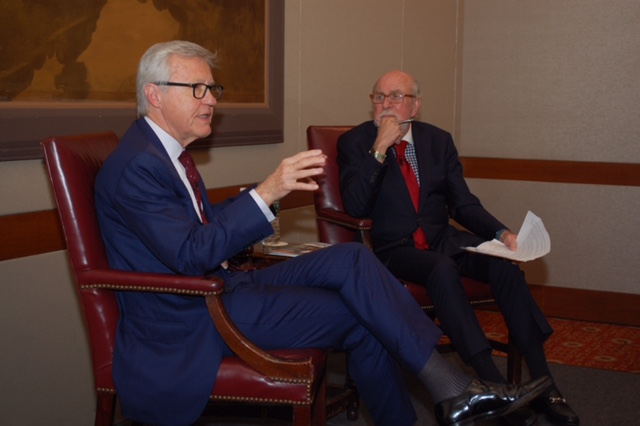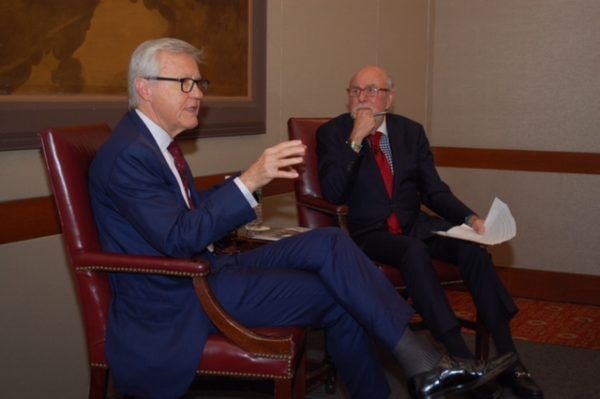ALLEN QUESTROM ANSWERS TOUGH QUESTIONS ABOUT RETAIL FAILURES


Last week’s fabulous Retail Marketing Society (RMS) breakfast on Wednesday morning featured retail icon Allen Questrom interviewed by The Robin Report founder and CEO Robin Lewis drew a sell-out crowd of retail VIPs to The Harvard Club in midtown Manhattan. In the second part of our coverage on this event, Questrom answers tough questions from the crowd. Here, his thoughts on why Ron Johnson failed at JCPenney and why Men’s Wearhouse elected to kill the brand DNA of Joseph A. Bank.
Would you talk a bit about Ron Johnson’s failed strategy at Penney’s?
I just read an article that stated retail boards are useless; I maintain that virtually all boards are useless. You can’t know a business by going there four times a year. You have to truly understand and question the strategy. And if you create a new strategy and apply it to an existing customer base, it’s not likely to work, even if it’s a viable strategy.
I believe that’s what happened with Ron Johnson at JCPenney. Ron is a very smart man: thoughtful, creative, with good ideas. But his vision—to upgrade the mix and presentation while eliminating sales (in an economic downturn)—did not resonate with Penney’s existing customer base. Sales dropped from $20 billion to $11.5 billion in just a year, not because it was a bad strategy (the product and presentation looked terrific) but rather because Penney’s customers opted to shop elsewhere where they could get the prices they were used to. (And once they’re gone, they don’t come back easily.)
Once this happened, I suggested they fire Johnson; why wait three more months? But the chairman wanted me to come in and visit with Ron. I said why: so he can kill me? I believe once some one’s out, he’s out.
You’re also on the Men’s Wearhouse board: Why did you let them kill the brand DNA of Joseph A. Bank?
First of all, we acquired Bank mostly because they came after us and we were the bigger company. And in fact, we didn’t totally eliminate promotions; we just wanted to get rid of the Buy One-Get Three mentality. And I take responsibility for that: I was aggressive in my belief that the Buy One-Get Three promotion was already dropping 10 percent and that continuing it would eliminate our quality customers, attracting only those who want really cheap suits. I suggested planning for a 20 percent drop in sales and I have to take full responsibility for pushing it. But an unexpected problem was that we made the move during a very warm fourth quarter which killed the sweater and outerwear businesses. So it was not a great season, but no—we did not eliminate all promotions; we still have plenty of sales.
Where do you see Joseph A. Bank in three years?
We need to redefine who we are, who the customer is. Men’s Wearhouse business is relatively strong: it’s younger, and we’re slowly eliminating some promotions. But Bank is more traditional; it needs better presentation. In clothing, these are $600 suits out the door at $300, so there’s value there. But it could take 3-4 years to turn it around.
So many retailers are obsessed with gross margin percentages but aren’t the dollars more important?
I think the most important factor is getting the product right and working in partnership with your vendors. They will do more for you when you work together; the best retailers are both tough negotiators and good partners.
But product and value are key: business is tough everywhere but the fast fashion chains are doing well. I was recently at Zara in Soho and the selling floors looked terrific, great designs under $100, with long lines at the register. Zara gets 17 visits per customer per year vs. 4 for the average store; they have two new lines coming in per week and they are able to offer designer knock-offs before the designers even ship the regular stores. So why aren’t department store merchants adding a fast fashion section in their stores? They need to attract millennials who are not interested in typical department stores that are boring, not aspirational, loaded with sale signs. We need new ideas for a new generation.
The retail training grounds used to be A&S, Macy’s and Bloomingdale’s; Where do you suggest aspiring retail execs start their careers these days?
Total retail sales have grown 3 percent a year for the past 5 years; ecommerce has grown 14 percent a year for the past 5 years and Amazon has grown 28 percent a year for the past 5 years, so it’s tempting to say Amazon. It’s projected that by the year 2020, Amazon will do $52 billion in apparel. They have seven private brands and amazing analytics that can detect the white spaces. But will they be a fashion force? It’s questionable. Jeff Bezos is not a merchant; he’s a brilliant operations engineer. He tries everything but there’s always a reason why he doesn’t make money. And a good 65 percent of their business is done by other companies. So I’m not sure that online will ever be a winning proposition, especially with 18 cents of every dollars spent on fulfillment.
Take Wal-Mart, for example. They are terrific merchants with a $500 billion business but they’ve spent a fortune to develop online. With 57 percent of their sales in groceries, I wouldn’t have invested online. They have customers coming in every week for groceries: why not ensure that they spend on other categories while they’re there? Make the apparel offerings more exciting, offer fast fashion, upgrade the presentation. If they would focus on in-store rather than online, they could kill the competition by increasing non-grocery sales to their regular frequent shoppers.
For information on the next RMS presentation on Thursday, June 9 entitled “The Future of Retail: It Ain’t What It Used to Be,” visit: retailmarketingsociety.org.









I agree with Allen Questrom regarding Jos A Bank and its future……..if there is one.
Jos A Bank requires a marketing strategy that is separate and apart from the marketing of the other brands in the
Mens Wear House portfolio ……Jos A Bank should have a group that lives , breaths and eats tradition ……….this group should have autonomy to be involved in all phases of the turn around ( marketing, merchandising, identity system,
store design, etc)…..very much like Dockers when Levi Strauss launched it.
Leave the promotional component but down play it a bit…..TELL THE BRAND STORY……then the consumer will have an
emotional connection ( Ralph Lauren/ Polo)